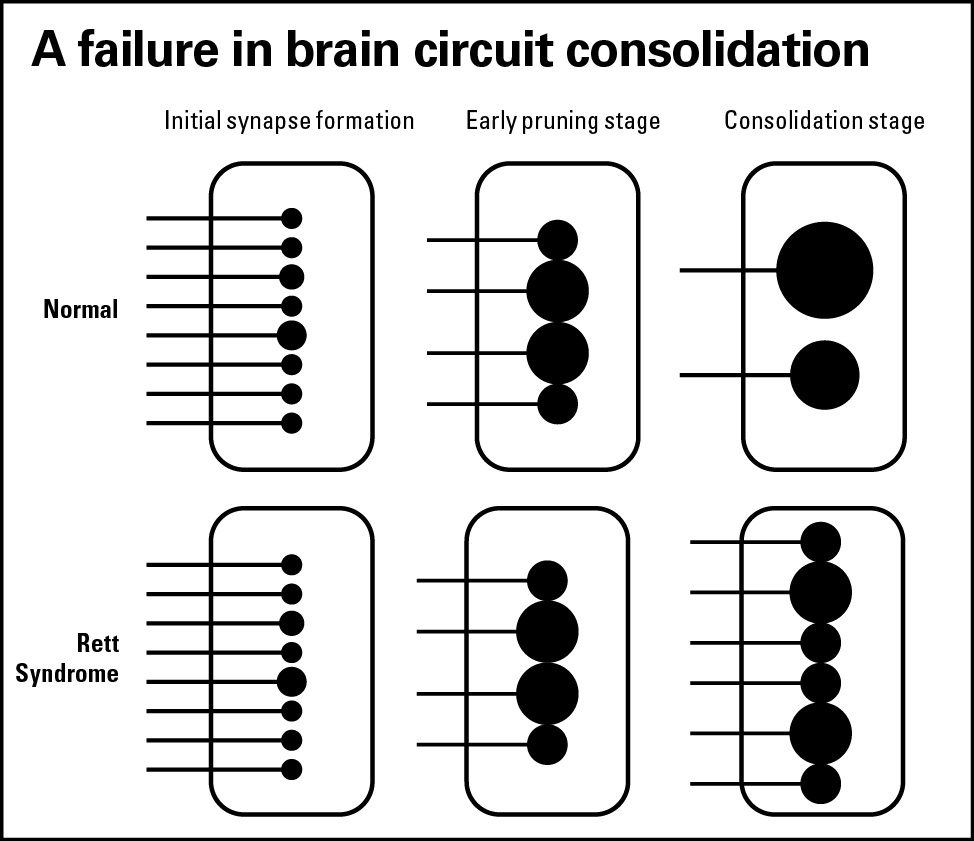 Many autism spectrum disorders (ASDs) are marked by apparently normal development in infancy followed by a tragic loss of cognitive, social and language skills starting at 12 to 18 months of age. ASDs are increasingly seen as a disorder of synapses, the connections between neurons that together form brain circuits.
Many autism spectrum disorders (ASDs) are marked by apparently normal development in infancy followed by a tragic loss of cognitive, social and language skills starting at 12 to 18 months of age. ASDs are increasingly seen as a disorder of synapses, the connections between neurons that together form brain circuits.
What hasn’t been clear is why children with ASDs go off the normal trajectory after meeting their early developmental milestones. But now there may be a hint of an explanation.
There’s one ASD that has a good mouse model — Rett syndrome. New research in these mice is shedding new light on the developmental question, suggesting that synapses and circuits are prevented from refining in response to input from the environment — just at the time when the brain should be maximally receptive to this input.
Chinfei Chen, of Children’s F.M. Kirby Neurobiology Center, led a team that studied mice with mutations in Mecp2, the causative gene in Rett syndrome. They used a visual circuit — connecting neurons in the eye’s retina with the thalamus of the brain – as a stand-in for circuit development generally, and tested its functioning by measuring its electrical responses to stimulation.
These electrical recordings indicated that the circuit at first forms normally in the Rett mice. During the second week of life, weaker synapses are pruned away and others are strengthened, just as they should be — shown in middle column below. But after day 21 of life — after mice open their eyes and when the visual circuitry should be consolidated based on visual experience — it became abnormal, as indicated in the third column. Synapses fail to strengthen further and actually increase in number.
“During this last phase of development, when you need sensory input to lock down the connections, the circuit continues to look around for the right connections,” says Chen.
That may alter how children with Rett and other ASDs process experiences and where they place their focus. Chen cites research from Yale that found that 2-year-olds with autism tend to gaze at peoples’ mouths rather than their eyes.
Probing further, the same group found a possible explanation: the toddlers with autism were fascinated by the audiovisual synchrony of lip motion and speech sound, while their unaffected peers focused on socially meaningful movements and facial expressions. In experiments, the typical toddlers paid more visual attention to dot patterns suggesting cartoon characters when they were displayed properly rather than upside down. In contrast, the toddlers with autism showed no particular preference for the right-side-up characters.
With one exception. When the characters were playing “pat-a-cake,” the autistic toddlers shifted their attention to the upright figures. The synchrony of the clapping sound with the visual of dots coming together– which markedly drew their attention — worked only when the figure was upright, not when it was upside down. It was the synchronization that fascinated them, not the social meaning.
Getting back to the mice, Chen thinks the children with autism have veered off the normal path because of differences in how they take information in during a critical period in development. “Many ASDs manifest between 1 and 2 years of age, a period when kids are interacting more with the outside world,” says Chen. “What’s being perceived is different, so the response is different.”
Chen’s lab is investigating whether reactivating the Mecp2 gene at different times in the mice could improve organization of the visual circuitry - indicating that the brain is still amenable to change. In the meantime, she notes that circuit problems occur at a time when intensive behavioral interventions, which can reinforce important signals, seem to be very effective.
“If you could diagnose early enough, there might be a way to alter the course of the disease by modifying experience, such as through intense one-to-one therapy,” she says.







